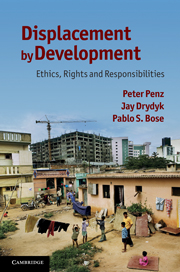Book contents
- Frontmatter
- Contents
- List of tables
- Acknowledgements
- 1 Introduction
- PART I FUNDAMENTALS
- PART II FROM COST–BENEFIT ANALYSIS TO ETHICS
- 4 Cost–benefit analysis and compensation
- 5 Guidelines and rights
- 6 The development ethics framework
- PART III FROM VALUES TO RESPONSIBILITIES
- PART IV REALIZING RESPONSIBILITIES
- Bibliography
- Index
5 - Guidelines and rights
Published online by Cambridge University Press: 05 June 2012
- Frontmatter
- Contents
- List of tables
- Acknowledgements
- 1 Introduction
- PART I FUNDAMENTALS
- PART II FROM COST–BENEFIT ANALYSIS TO ETHICS
- 4 Cost–benefit analysis and compensation
- 5 Guidelines and rights
- 6 The development ethics framework
- PART III FROM VALUES TO RESPONSIBILITIES
- PART IV REALIZING RESPONSIBILITIES
- Bibliography
- Index
Summary
Displacement may always have been concomitant with development, particularly since the rise of capitalism, but it was only in the 1980s that international policy guidelines were formulated to regulate it. For a number of reasons, it was at the World Bank that guidelines emerged first and foremost. First, infrastructure development is the primary cause of displacement for development, and until the 1970s the Bank's loans were given almost exclusively to infrastructure projects (Gavin and Rodrik, 1995: 333). In addition, social anthropologists had been studying the social consequences of involuntary resettlement on several continents, including resettlement for the sake of projects financed by the Bank (Partridge, 1989: 374) – notably Elizabeth Colson's Social Consequences of Resettlement, based on research on effects of the Kariba dam project on the Gwembe Tonga (1971). A growing body of evidence pointed to a number of problems in projects involving resettlement, including: denial of responsibility; poor preparation; underestimation of affected population; high risk of impoverishment; underfinancing of resettlement; damaging environmental impacts; weak institutional capacity; and lack of consultation with affected persons and their communities (Partridge, 1989: 377–80). The contradiction between these impoverishing effects and the new anti-poverty thrust of the MacNamara period (1968–81) provided not only motivation, but also an opening for advocates of guidelines to regulate resettlement for Bank-funded projects. In the words of one observer, ‘With few exceptions, the Bank's traditional approach was to leave resettlement to the borrower country and out of the project's design, preparation and loan appraisal processes’ (ibid., 377).
- Type
- Chapter
- Information
- Displacement by DevelopmentEthics, Rights and Responsibilities, pp. 84 - 115Publisher: Cambridge University PressPrint publication year: 2011

